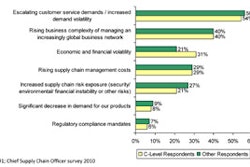The world of ubiquitous radio frequency identification tags has yet to materialize. We still await the day when we can load our grocery carts with goods, pass the whole cart through a scanner and, with a wave of our RFID-enabled credit card, waltz boldly out of the store into the brave new world of track-and-trace.
And yet RFID has been making steady inroads into the supply chain over the past decade. Research firm IDTechEx (www.IDTechEx.com) reported recently that the global RFID business has grown about fivefold in the last 10 years, and the firm's chairman, Peter Harrop, has projected that the market will grow more than fourfold over the 10 years ahead. Some market segments are likely to see even faster growth, with the apparel supply chain, for example, seen adopting RFID at twice the rate of the overall RFID market, according to Harrop.
Despite these rosy projections, however, the economic turmoil of the past two years has undoubtedly had an impact on the RFID market, according to Shel Myeroff, president of Direct Recruiters (www.directrecruiters.com), a Cleveland-based executive search firm that places sales and technical staff with vendors that sell supply chain solutions to end user companies. "Real demand for these solutions is still pretty low," Myeroff says. Not that companies aren't interested in achieving the benefits of RFID, he adds. Rather, end users are having trouble justifying the investment and "pulling the trigger" on projects at a time of economic uncertainty. As a result, vendors have focused on offering solutions that are low cost, can be implemented quickly, and can provide fast return on investment.
Myeroff does note that one bright segment of the market has been for solutions for tracking assets in the enterprise. He particularly singles out the medical space, where, for example, hospital organizations are looking to track everything from expensive pieces of equipment to the patients themselves. Michael Liard, an analyst with the firm ABI Research (www.abiresearch.com), also has noted that growth in the market for RFID — and the broader category of real-time location systems (RTLS) — is being driven by businesses that are seeking to gain increased levels of visibility into the status of their assets. As Liard said in a recent statement from ABI regarding higher-frequency RFID and RTLS-enabled asset tracking and asset management tags: "The basic function of asset tracking is to answer the question, 'Where has my stuff been?' Asset management, based on real-time location technologies, refines that question to 'Where's my stuff right now?' Some new systems even add sensors, allowing the additional question, 'How are my assets?'"
Beyond medical and other asset-tracking applications, however, Myeroff says that end users still frequently struggle to understand where the return on investment will come from with RFID systems. Vendors in the marketplace, he says, must get better at articulating — and proving through examples — the ROI on RFID in order to spur greater investment in the solutions. "Companies may want to buy RFID and implement it, but they don't know what their cost savings will be," he says.
Are you investing in RFID? Planning to invest? Still locked into the barcode? Drop me a line at [email protected] to share your thoughts. I'll look forward to hearing from you.
— Andrew K. Reese
Editor, Supply & Demand Chain Executive

















